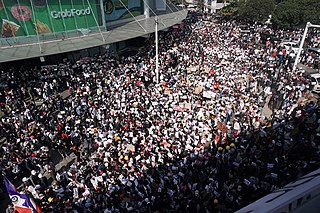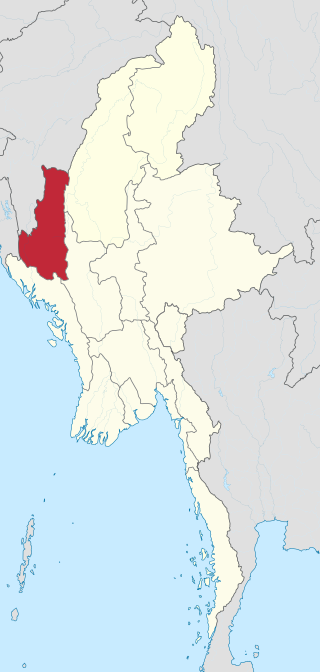
The Arakan Army is an ethnic armed organisation based in Rakhine State (Arakan). Founded on 10 April 2009, the AA is the military wing of the United League of Arakan (ULA). It is currently led by commander in chief Major General Twan Mrat Naing and vice deputy commander Brigadier General Nyo Twan Awng. The Arakan Army states that the objective of its armed revolution is to restore the sovereignty of the Arakan people. In a February 2024 interview, Twan Mrat Naing claimed that the AA had grown to at least 38,000 troops. Anthony Davis, an expert of military and security, rejected this claim and estimated that it has at least 15,000 troops in Chin State and Rakhine State, in adition to around 1500 in Kachin and Shan State. In the early 2010s, the Arakan Army fought alongside the Kachin Independence Army (KIA) against the Tatmadaw in the Kachin conflict. Following the 2016 outbreak of conflict in Rakhine state, AA became more heavily involved in the Arakan region. In 2019, AA would launch attacks on state security forces and the Myanmar Army would respond heightening clashes. The AA reached a ceasefire in late 2020 after eroding the central government's control in northern Rakhine. The power vacuum would be filled by the AA over the next 18 months with state-building efforts, like their COVID-19 vaccine rollouts.
2021 (MMXXI) was a common year starting on Friday of the Gregorian calendar, the 2021st year of the Common Era (CE) and Anno Domini (AD) designations, the 21st year of the 3rd millennium and the 21st century, and the 2nd year of the 2020s decade.

Protests in Myanmar, known locally as the Spring Revolution, began in early 2021 in opposition to the coup d'état on 1 February, staged by Min Aung Hlaing, the commander-in-chief of the country's armed forces, the Tatmadaw. As of 23 June 2022, at least 2000 protesters have been killed, 14,000 currently arrested and 700,000 displaced by the junta.

The timeline of the 2021 Myanmar Revolution chronicles the 2021 Myanmar protests, known locally as the Spring Revolution, that began in early 2021 in opposition to the coup d'état on 1 February, staged by Min Aung Hlaing, the commander-in-chief of the country's armed forces, the Tatmadaw.

The National Unity Government of the Republic of the Union of Myanmar is a Myanmar government in exile formed by the Committee Representing Pyidaungsu Hluttaw (CRPH), a group of elected lawmakers and members of parliament ousted in the 2021 Myanmar coup d'état. The European Parliament has recognized the NUG as the legitimate government of Myanmar. It includes representatives of the National League for Democracy, ethnic minority insurgent groups, and various minor parties.

The People's Defence Force is the armed wing of the National Unity Government (NUG) in Myanmar. The armed wing was formed by the NUG from youths and pro-democracy activists on 5 May 2021 in response to the coup d'état that occurred on 1 February 2021 that put the military junta and their armed wing the Tatmadaw in power. The military junta designated it as a terrorist organisation on 8 May 2021. In October 2021, NUG's Ministry of Defence announced that it had formed a central committee to coordinate military operations across the country.

The Myanmar civil war, also called the Myanmar Spring Revolution or People's Defensive War, is an ongoing civil war following Myanmar's long-running insurgencies, which escalated significantly in response to the 2021 military coup d'état and the subsequent violent crackdown on anti-coup protests. As of January 2024, recent losses have meant the surrender of thousands of soldiers, including six generals and thousands who have surrendered without a fight. However, others warn that coup forces remain "formidable and well-equipped", with "external allies and economic resources".

The Chinland Defense Force is a rebel group in Myanmar. It was formed in response to the 2021 Myanmar coup d'état to protect Chin State from the military junta. The CDF claims that they do not attack the military without cause and that they always issue a warning, such as releasing detainees and refraining from using violence against civilians. If the military does not respond, guerrilla or other action follows. They promise to return their weapons and disband if the revolution is successful. CDFs are members of CJDC. Chinland Joint Defense Committee (CJDC) is formed to serve Chin people's security services and protect an enemy from the illegal Myanmar Army. The total strength of active personnel under the command of CJDC is approximated to be around 15,000. From August to October 2021, it was reported that at least 40 clashes occurred between junta troops and CDF in various townships. CJDC claimed that at least 1,029 Tatmadaw soldiers were killed in the clashes and lost 58 of their own in 2021.
Events in the year 2022 in Myanmar.
The following is a timeline of major events during the Myanmar civil war (2021–present), following the 2021 military coup d'état and protests. It was also a renewed intensity in existing internal conflict in Myanmar.
This is the list of important events happened in Myanmar in 2023.
Lieutenant General Nyunt Win Swe is a Burmese military officer and current commander of Myanmar's Yangon Command.
The Hlaingthaya massacre was a mass killing of civilians on 14 March 2021, in Hlaingthaya Township, Yangon, Myanmar. During the massacre, Myanmar Army troops and Myanmar Police Force officers killed at least sixty-five individuals. The massacre became one of the deadliest domestic incidents to occur in the aftermath of the 2021 Myanmar coup d'état, and marked a serious escalation in the military's violence against civilians resisting the coup. The violent crackdown also precipitated a mass exodus of factory workers, residents, and businesses from Hlaingthaya, a major factory hub in the country.
The Let Yet Kone massacre was a mass killing of civilians on 16 September 2022, at a monastic school in the village of Let Yet Kone, near Tabayin in Sagaing Region, Myanmar. During the massacre, Myanmar Army and Myanmar Air Force troops killed at least 13 civilians, including 8 children. The event became one of Myanmar's deadliest civilian massacres involving children in 2022, during which 165 children were killed by military forces.
The Tar Taing massacre was a mass killing of civilians by Burmese military forces between 1 and 2 March 2023, in the village of Tadaing, Sagaing Region, located 28 miles (45 km) west of Mandalay, Myanmar's 2nd largest city. During the massacre, Myanmar Army troops killed at least 17 civilians. The event has become one of Myanmar's deadliest civilian massacres in 2023. Just nine days after this massacre, military troops killed at least 28 additional individuals in the Pinlaung massacre.
The Pinlaung massacre was a mass killing of civilians by Burmese military forces on 11 March 2023, in the village of Namneng, Shan State. During the massacre, Myanmar Army troops killed at least 30 civilians, including 3 Buddhist monks. The massacre occurred 9 days after the Tar Taing massacre in Sagaing.
The Mon Taing Pin massacre was a mass killing of civilians by Burmese military forces on 11 May 2022, in the village of Mondaingbin, Sagaing Region, Myanmar. During the massacre, Myanmar Army troops executed at least 37 villagers. Sagaing Region later became the site of several additional mass killings perpetrated by the Burmese military, including the Letyetkon and Tadaing massacres.

The Chin theater is one of the theaters of the Myanmar civil war (2021–present), with resistance forces fighting against the Tatmadaw military junta in Chin State, western Myanmar.
The Bago University Students' Union (BUSU) is a students' union at the University of Bago. It is the representative body of the students from most universities and faculties. Also, each university has its own students union to which elections are held every year. The student elections are fought keenly and with great enthusiasm.
The Three Brotherhood Alliance, also known as Brotherhood Alliance, is an alliance between the Arakan Army, Myanmar National Democratic Alliance Army, and the Ta'ang National Liberation Army formed in June 2019.










